Units of Exchange
post by CFAR!Duncan (CFAR 2017) · 2022-06-28T16:53:53.069Z · LW · GW · 28 commentsContents
The Lego Principle: Bricks and bargains Part I: Apples to oranges Moral: Costs and values are often made of multiple parts. Moral: Seek simple comparisons, but also mistrust them. Part II: Relevant value, relevant cost Moral: The real cost isn’t always on the sticker. Moral: Beware repeated costs—they add up! Part III: Diminishing returns Moral: Early gains tend to be the largest. Moral: Every strategy eventually stops being worthwhile. Part IV: Arbitrage Moral: Proper arbitrage isn’t win-lose, it’s win-win. You can reinvest the recouped resources however you want, including right back into the thing you just made more efficient. Part V: Opportunities for growth Units of Exchange—Further Resources None 28 comments
Epistemic status: Established and confirmed
The lessons taught in Units of Exchange are straightforward applications of extremely well-established principles from economics and sociology, such as supply and demand, Pareto curves, value of information, the sunk cost fallacy, and arbitrage. The causal relationships underlying by each of these principles have been robustly confirmed in a wide variety of domains, and the recommended actions we’ve derived from them are simple and fairly conventional.

A version of this course is taught near the beginning of every CFAR workshop, often as the very first class. That’s not because the concepts it covers are revelational or groundbreaking, but rather the opposite—they’re core concepts, fundamental prerequisites that underlie and inform much of the rest of our content.
If you’re already familiar with them—great! This is a quick-and-dirty overview—we don’t mean to condescend to people who’ve already had specific training in these fields, only to provide those same tools to all of our participants. If these are not the droids you’re looking for, feel free to skip ahead to Inner Simulator.
The Lego Principle: Bricks and bargains
If you’ve ever done proofs in math or logic, then you know that it’s possible to reach complex and interesting results by starting from a limited number of assumptions. The conclusions in Units of Exchange aren’t mathematically rigorous, but they do emerge from two key premises, which combine to form what we call the Lego Principle.
1. Things are made of parts
The first half of the Lego Principle is reductionism, or the idea that, having fully explained all of the components of a thing and how those components interrelate, there’s nothing left to say. Metaphorically, if one has described the trees, shrubs, and fauna in all of their relevant detail, one has fully explained the forest; there is no ephemeral “missing” property that is forest-ness.
Reductionism is a powerful concept, because it allows us to interface with complex phenomena by dealing with smaller, simpler sub-phenomena. Brains, emotions, societies, financial markets—these are all large, and sometimes daunting to engage with. But neurons, cognitive if-then patterns, social norms, and individual commodities are all at least relatively more tractable.

2. Parts may be exchanged
The technical term here is currencies, and the idea is that, just as we can trade dollars for pounds (and buy things with either, in a place like an international airport), so too can we trade money for effort or sleep for knowledge or respect for social influence. In particular, where things are made up of similar parts, we can make exchanges between them, swapping our resources around to prioritize what we think is important.

Most of the rest of this unit boils down to straightforward applications of these two premises. There are things that we want more of—time, money, motivation, pleasure, attention, energy, knowledge, stuff, sleep, respect, be- longing, accomplishment, the well-being of the people we care about. Some of these wants are instrumental—we want them because they will lead to other good things (money being the classic example). Others are more terminal— they’re good in and of themselves (such as happiness or satisfaction).
Since life isn’t perfect and most of us aren’t all-powerful, we make trade- offs. We skimp on sleep to get more work done, bail on a work party to spend time with a significant other, skip dessert because we’re trying to get in shape. To a great extent, making good decisions can be framed as paying close attention to the exchange rates between these various currencies.

Part I: Apples to oranges
Some people benefit from converting everything in their lives to a common currency. You can imagine a particular “chunk” of good, like your favorite menu item at your favorite restaurant, and make productive comparisons. Will this vacation be worth 100 sesame chicken dinner combos? Are you willing to have one less dinner combo per month, to pay for a gym membership? Is the amount of happiness you’re expecting to get out of a frivolous purchase more or less than a couple of dinner combos?
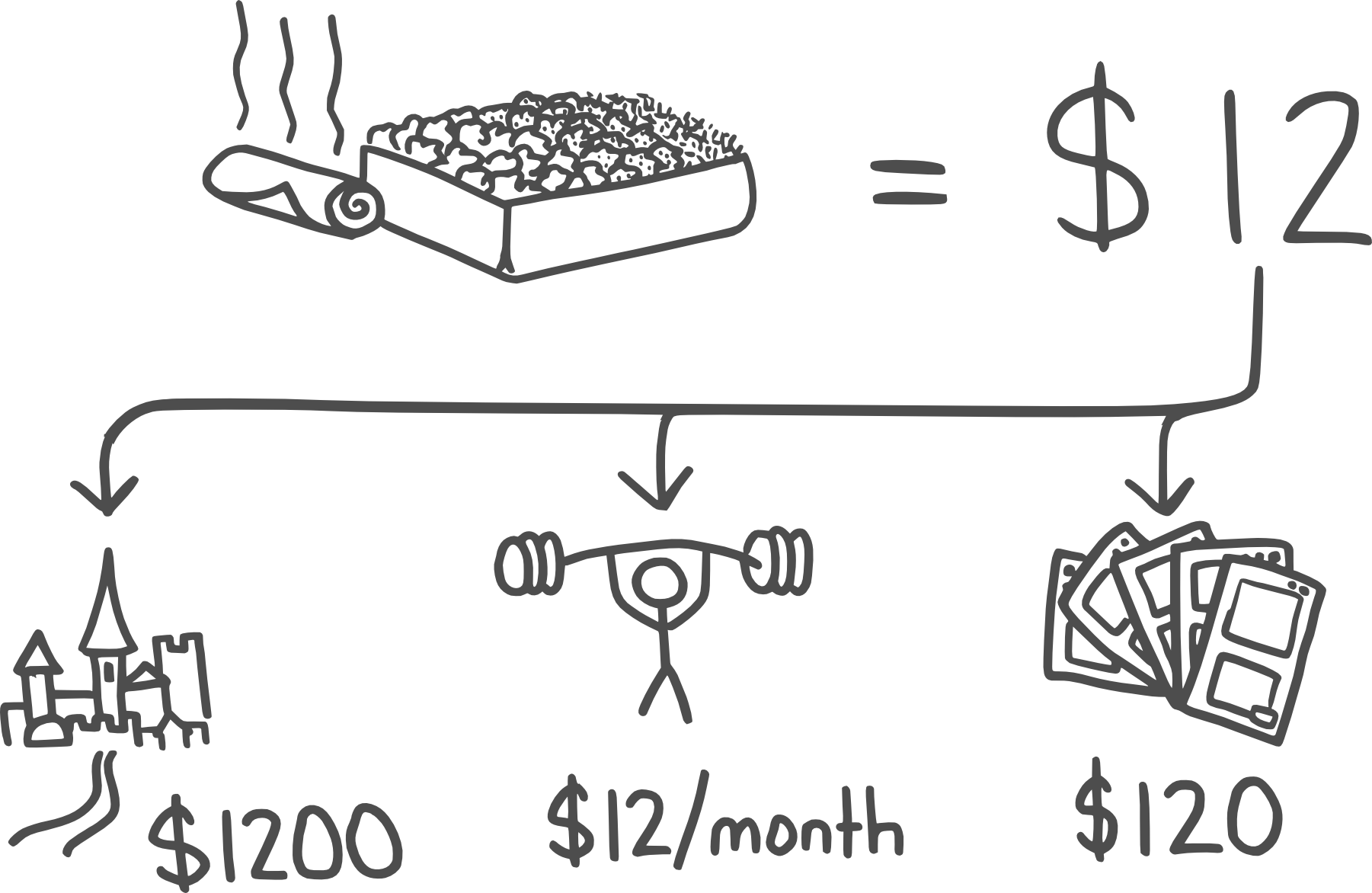
This can be a valuable exercise in many ways, but it’s important to recognize that it’s a simplification, a shorthand. Most of the things we do involve multiple currencies, and when you try to boil them down to a single number, you’ll often find that you’re either leaving things out or spending way too much time arriving at exactly the correct appraisal. Your dinner combo may cash out in your head to $12, but it also takes time to order, and saves time otherwise spent cooking. It provides a certain amount of visceral satisfaction, and hits or misses various nutritional goals. It may be part of a weekly tradition with friends where you gain social value. It’s complex, with lots of moving parts.
This is true of many currency-type situations. One of the most common exchanges in our society is in the workplace, where we trade time and effort for money. Yet many of us work jobs that pay “less than we’re worth,” because money is not the only thing we’re getting out of the transaction—think of altruists and philanthropists working at non-profits, or people taking a risk on their big startup idea. When we consider the value of our time, money is a good first approximation, but it’s rarely the whole picture. If you offer me $1 per hour to sort pencils, I’ll say no; offer me $1000 per hour, and I might say yes. By negotiating back and forth, we can get a sense of my default hourly rate for thankless tasks—but that doesn’t touch on tasks that aren’t thankless, or issues of supply and demand and specialization.

Teachers often exchange large amounts of time and effort for moderate amounts of money, but large amounts of personal satisfaction and a chance at greater impact.
Moral: Costs and values are often made of multiple parts.
Moral: Seek simple comparisons, but also mistrust them.
Part II: Relevant value, relevant cost
Imagine that you’re in the market for a new microwave. You’re standing in the aisle, looking at three options—one for $89, one for $199, and one for $389. How do you decide?
It may be that you have a certain budget for microwaves, and that’s that—sometimes, a particular currency is the overwhelming limiting factor, and if your bank balance is low, all other considerations come second. But imagine that you have room to at least consider all three options. What are the relevant details?

Cost is one, obviously. Quality is another—some combination of power, reliability, versatility, and durability. Aesthetics might also be a factor, or energy efficiency, or ease of use.
The consideration that most people miss, in this case, is time. A microwave is a device you’re likely to use almost every day, perhaps multiple times a day, and a quick Google search shows that the average microwave lasts around nine years. That’s somewhere between two and three thousand uses, at a minimum. This means that the difference between a microwave that heats your food properly in two minutes on the first round and one that takes four or five minutes with repeated breaks to check and stir is enormous. It’s an extra frustration on or off the pile every day for years; an extra hour saved or wasted every month.
You can do a similar calculation based on how much happiness or satisfaction you get from evenly-heated food versus food that's boiling in some spots and cold in others; the difference between, say, "zero-point-two 'happies' per microwave use" can add up!

That doesn’t necessarily mean that the most expensive option is always the right choice. But it’s a valuable way to reframe the problem. When you’re standing in the store, it’s easy to think that the only tradeoff is between money and quality. It’s hard to remember that “quality” has other ramifications, and usually worthwhile to unpack them, at least a little. You might save a couple hundred bucks on the spot, only to lose a dozen hours in the future—a dozen hours that, for most of us, are ultimately worth much more than the one-time hit to our bank balance.
Moral: The real cost isn’t always on the sticker.
Moral: Beware repeated costs—they add up!
Part III: Diminishing returns
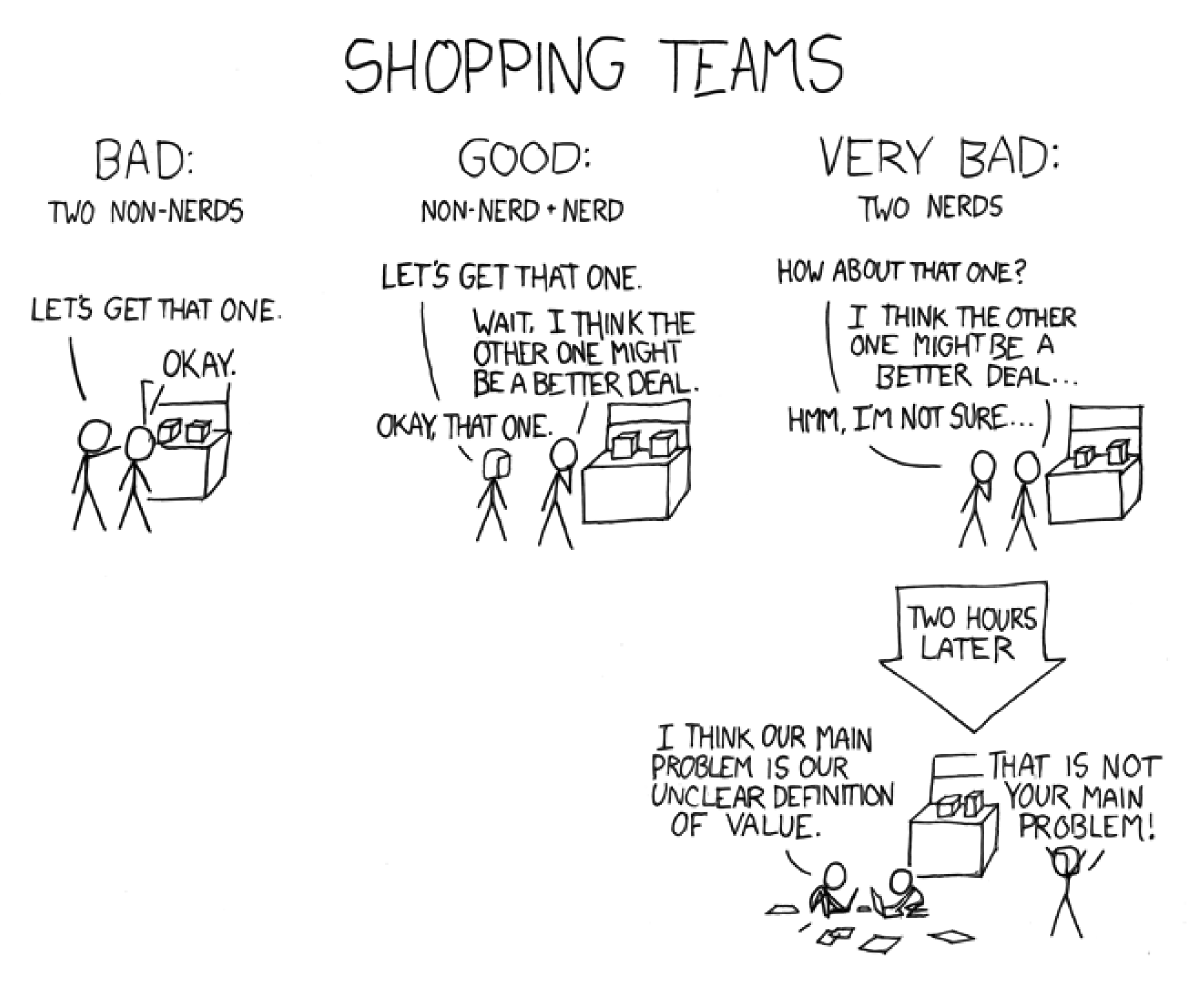
There is a cost to pursuing any strategy, whether it’s in time, money, effort, resources, etc. Most strategies have diminishing returns, meaning that, as you keep at them, you get less and less out of an additional marginal bit of effort. Think about continuing to make sales calls in a small city after you’ve already tapped all of the obvious buyers, or clicking forward to the tenth page of Google results, or eating your fifth slice of pizza.
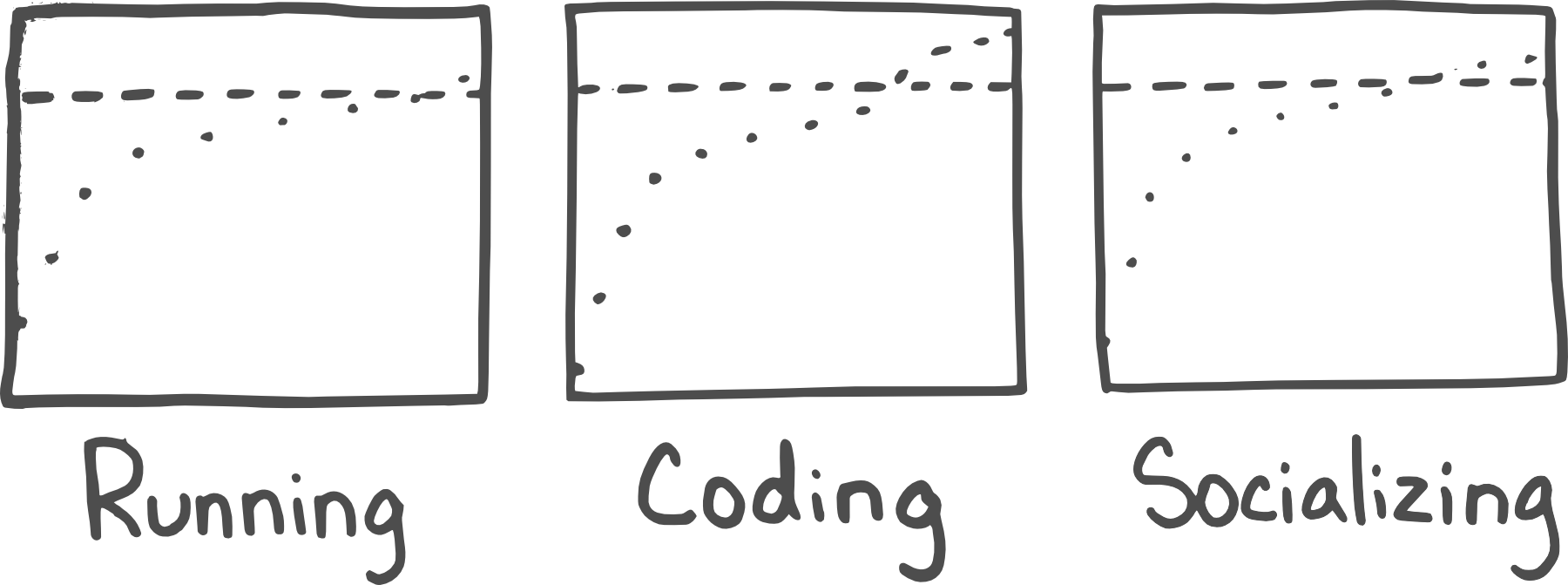
There’s a general principle (often called the Pareto principle or the 80/20 rule) which states that eighty percent of the results come from twenty percent of the effort. It’s not a hard-and-fast rule, of course, and there are situations where it doesn’t apply at all. But for many strategies, it’s best to put forth strong effort in the early stages, get the bulk of the low-hanging fruit, and then switch to something else. When you start running, or begin coding, or change the way you socialize, you’ll see steep improvement that eventually starts to level off.
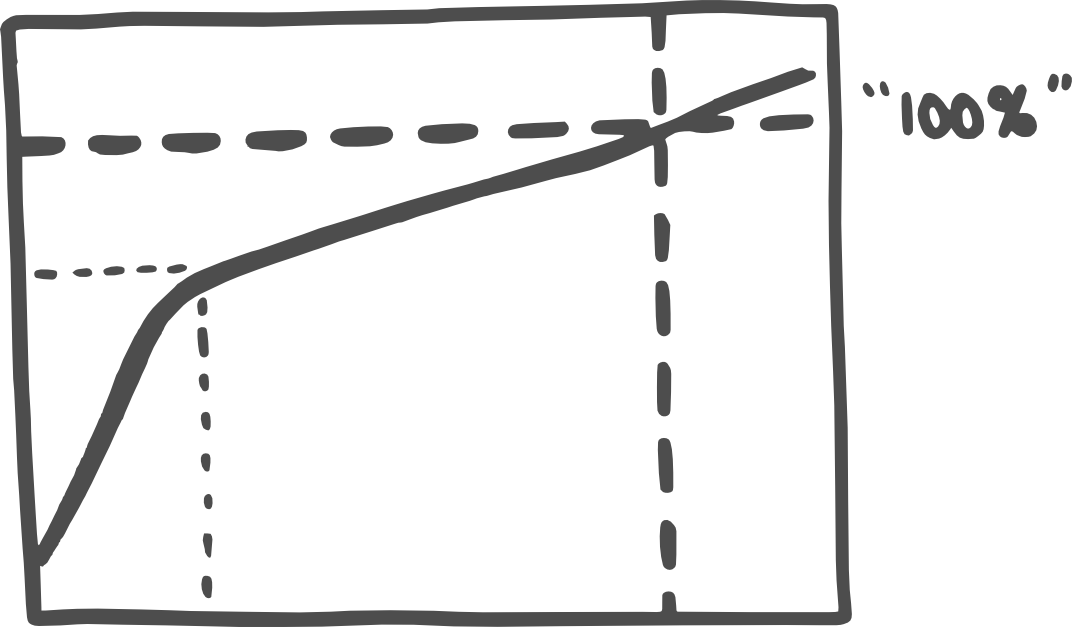
Consider “information” as an example. The value of information is how much better you expect your life to be based on the information you’re seeking—a balance of how much of a difference that information could make, and how likely it is that it will make that difference. For instance, if you’re searching for plane tickets, more information could conceivably save you hundreds of dollars, but the odds of you finding such significant savings may not be clear.
Most of us have an instinctive grasp of this principle. If the first ticket we come across is $1500, we immediately glance down the page to get a sense of the possible savings—are all of the options in the same range, or do some of them dip down below $1000? We then spend time and effort accordingly—if it feels like an extra ten minutes of digging might save us five hundred dollars, we keep going, and if it feels like we’ve pretty much seen all there is to see, we stop searching and buy the best ticket we’ve found so far.
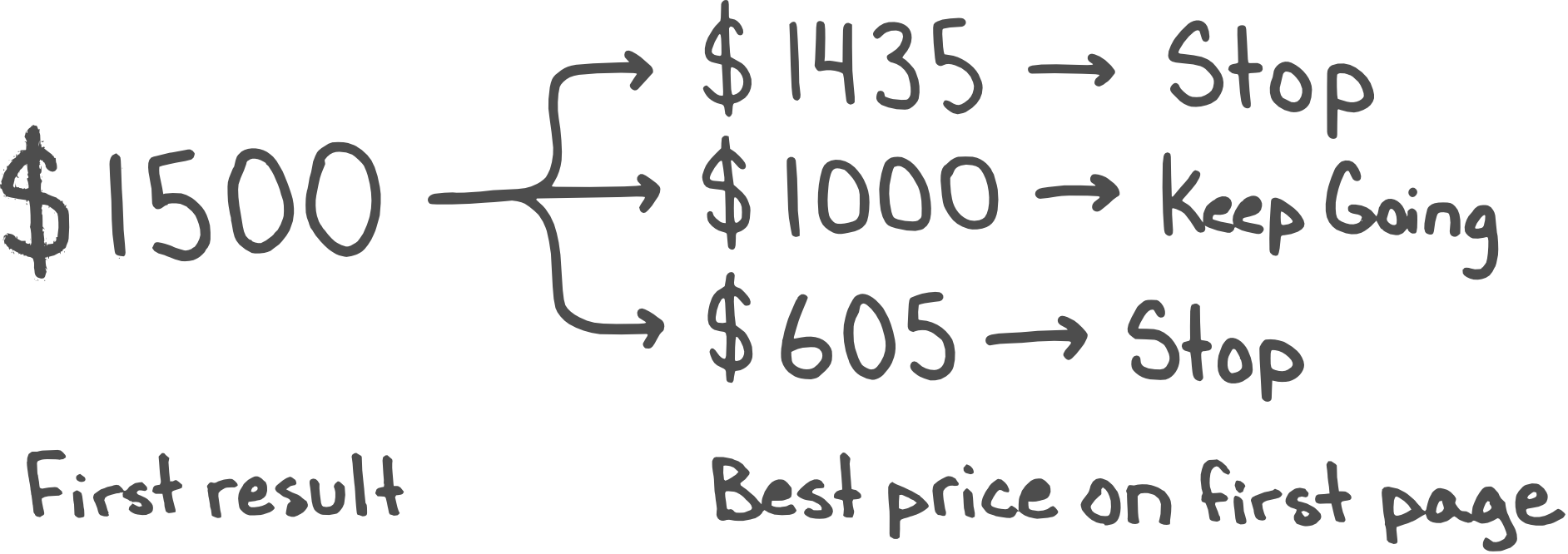
The key is to employ this same metastrategy everywhere it makes sense. Keep your eye on the marginal value of each extra hour, each extra dollar, each extra drop of motivation or discipline, and when that value starts to dip, use that as a reminder to ask yourself: do I expect this strategy to continue paying for itself, or is it time to change course?
Moral: Early gains tend to be the largest.
Moral: Every strategy eventually stops being worthwhile.
Part IV: Arbitrage
“Arbitrage” is an economics term that essentially boils down to “take advantage of the fact that things have different prices in different places.” If silver costs $5 per ounce in one part of the world, and $25 per ounce in another, and you have the proper logistics in place, you can buy an ounce where it’s cheap, sell it where it’s expensive, then take the $25 you’ve earned and use it to buy five ounces, sell them both, and so on.

Arbitrage has the effect of leveling out prices—you can’t keep that process going forever, because at some point the supply in the cheap place will drop, and the demand in the expensive place will drop, and things will be consistent between the two markets. But in the meantime, you can exploit the inconsistency to make money out of (essentially) nothing.
There are similar opportunities for arbitrage in our own personal “currency markets.” Most of us are inconsistent in how we prioritize time, money, energy, social effort, and other resources—we overspend in some areas and underspend in others, effectively “narbitraging” ourselves. By targeting those inconsistencies and shifting resources around, we can create extra value even without adding anything new to the system.
We’ve already touched on one example above—we lean toward buying the cheaper microwave to save money, but may overlook the possibility that buying the more expensive one can save us significant amounts of time, some of which could be used to earn more money than we spent in the first place. Paying attention to the relationship between time and money in the long term changed the calculus of the purchasing decision, likely for the better.
Other examples:
Someone who rigidly holds themselves to a superstrict diet and spends lots of willpower to (e.g.) turn down delicious homemade cake at a party, and then burns out and binges on cheap potato chips three days later. The currencies being traded here are effort, health, and food-related happiness; this person bankrupted themselves on the former, and got compromised versions of both of the latter. If instead they had eaten some cake, they would have retained willpower, taken a comparable hit to their health, and gotten significantly more food-related happiness—a better outcome.

Someone who consistently struggles to come up with thoughtful, meaningful gifts for their family and friends, and who usually spends the week before Christmas or birthdays wracked with guilt and stressing out over what to make or buy. The currencies being traded here are time, attention, and goodwill/warm fuzzies; this person spends a large amount of both of the former for uncertain results on the latter. If they instead create a single, easy place to store gift ideas year-round, they can decrease the costs in time and attention and be more likely to pinpoint and remember the things their families and friends actually want.

Someone who spends dinner time bouncing back and forth between work texts/emails and conversation with family and roommates. Currencies being traded here are time, attention, effectiveness, and the other diners’ sense- that-they-matter; by juggling two important things, this person is likely to fail at both. If they instead shorten their dinner commitment to twenty minutes, but are fully present before going back to work, they can spend the same amount of time, reduce attention overhead and switching costs, and improve both their ability to get the work done and to show affection for their family and roommates.
The most important piece of this puzzle is the recognition that attention to tradeoffs ≠ being cold and calculating. Often we feel a little strange doing things like arranging to see all of our friends at the same party, because there is a sense that this is cheating or manipulative or somehow disingenuous. And it’s true that making small, specific sacrifices in the process of seeking arbitrage can draw your attention to tradeoffs that are somewhat uncomfortable.
But it’s important to recognize that those tradeoffs were already happening. It’s like hospital administrators making tough calls between expensive procedures for sick children and new equipment or raises for surgeons. We already trade time against money against effort against happiness against social capital—we can do so blindly, and hope for the best, or we can think about them carefully and deliberately, and take advantage of opportunities to get more of everything. If your schedule is overloaded, you’re already shortchanging your friends by being distracted or exhausted or otherwise sort-of-not-really-there for them; rearranging things to see more of them in groups isn’t taking anything from them, and it’s giving back to yourself.
(And if it turns out that it is taking something from them—if you discover that some of those relationships need more one-on-one time than you thought—you can change the plan again!)
This is the key. You have limited amounts of time/money/effort/etc., so it makes sense to waste them as little as possible—you’re not looking to sacrifice one part of your life for the sake of another, you’re looking for ways to increase one part at no cost to the other, or to raise the overall available amount of every currency by fixing the leaks.
Moral: Identify all relevant currencies, and note which are being spent faster or are more valuable
Moral: Proper arbitrage isn’t win-lose, it’s win-win. You can reinvest the recouped resources however you want, including right back into the thing you just made more efficient.
Part V: Opportunities for growth
The following are some areas where many CFAR alumni have found significant opportunities for improving the tradeoffs they were making:
- Rearranging commutes or other regular time commitments
- Improving reading or typing speed; switching to audio books
- Using earplugs, eye masks, and white noise to improve sleep quality
- Regular re-evaluations of job, career, salary, project, team role, etc.
- Efficiency systems like keyboard shortcuts, email routines, & to-do lists
- “Batching” small recurring tasks to avoid switching costs
- Making one-time purchases (including “purchases” of time, energy, or social effort) that remove or reduce the cost of a repeated expense
- Using Craigslist, Uber/Lyft, Ebay, OKCupid/match.com, mailing lists, and event calendars
Units of Exchange—Further Resources
Explicit calculations are useful in part because people’s intuitions often have a hard time dealing with quantities (for a review, see Kahneman, 2003). In a classic study on scope neglect, people were willing to spend about as much to save 2,000 birds as to save 200,000 birds. Similar insensitivity to variations in quantity, which Kahneman (2003) calls “extension neglect,” arise in other contexts. For example, people’s evaluations of an experience (such as a medical procedure without anesthesia) tend to be relatively insensitive to its duration (compared to the peak level of emotion).
Kahneman, D. (2003). A perspective on judgment and choice: Mapping bounded rationality. American Psychologist, 58, 697-720. http://tinyurl.com/kahneman2003
People are more sensitive to quantities when they can make side-by-side comparisons of multiple options which vary on that quantity or when they have enough familiarity with the subject matter to have an intuitive sense of scale, but in the absence of these conditions a person’s intuitions may be essentially blind to the magnitude of the quantity (Hsee, 2000). In order to incorporate the magnitude in one’s judgment, it may be necessary to engage in explicit effort to make sense of it.
A review article on “attribute evaluability,” which is the extent to which a person is sensitive to quantitative variations in an attribute:
Hsee, C. K. (2000). Attribute evaluability and its implications for joint- separate evaluation reversals and beyond. In D. Kahneman & A.Tversky (eds.), Choices, Values and Frames. Cambridge University Press. http://goo.gl/3lXoD
Research on decision making suggests that people who care a lot about mak- ing the best decision often neglect the implicit costs of the decision making process such as time and money. For example, they might spend a lot of time trying to pick a good movie to watch (neglecting the time cost) or channel surf while watching television (neglecting how dividing attention can reduce enjoyment); self-reports of both behaviors have been found to correlate with personality trait of “maximizing.”
Schwartz, B., Ward, A., Monterosso, J., Lyubomirsky, S., White, K., & Lehman, D.R. (2002). Maximizing versus satisficing: Happiness is a matter of choice. Journal of Personality and Social Psychology, 83, 1178-1197. http://goo.gl/HLImnQ
Alumni Lincoln Quirk’s essay on how to put a dollar value on one’s time: http://goo.gl/fVDuFj
A blog post with several vignettes in which VOI calculations are relevant:
http://lesswrong.com/lw/85x/value_of_information_four_examples/
The introduction to Aaron Santos’s book provides a simple guide for how to make rough estimates of quantities, and how to break a difficult-to-estimate quantity into components. The rest of the book contains sample problems for practicing Fermi estimation.
Santos, Aaron (2009). How Many Licks? Or, How to Estimate Damn Near Anything. http://goo.gl/8ytNye
Related comics and essays by Randall Munroe:
"Is It Worth the Time?"
28 comments
Comments sorted by top scores.
comment by AnthonyC · 2022-06-29T20:50:55.083Z · LW(p) · GW(p)
you can change the plan again!
This is one point that, while obvious, seems hard for a lot of people to notice in practice. As an example, my wife and I recently sold our house and are RVing full time. We've noticed (and are told this is common) that many times we had conversations that went something like this:
"Oh, what's your destination?"
"We don't have one, but for the next few months we're heading vaguely [direction]."
"Oh, so you're going to [place]?"
"No, it's not a trip/vacation, it's just life, and a few weeks after we get to [place] we'll move on, we just don't know where yet."
"Well, how long are you going to travel for?"
"We don't know, until we feel like doing something else."
And this just... doesn't seem to register as a thing you can do/expect to do for a lot of people. They seem to assume you have to at least start out thinking something is forever. Whereas for us, each incremental planning decision is a consideration of a set of potential options, a deliberate choice not to plan too far in advance and to routinely reconvene to see how things are going.
Replies from: SaidAchmiz, Valentine↑ comment by Said Achmiz (SaidAchmiz) · 2022-06-30T09:25:51.034Z · LW(p) · GW(p)
While I completely agree with your broad point (i.e., your last paragraph), I think that part of the reason for the reactions you’re describing is that, to most people, living in an RV and being on the road as a potentially long-term lifestyle (as opposed to just a way of traveling to some location) naturally seems like it would be so terrible, so unlike anything that they’d ever want to do, much less choose to do of their own free will, that they do not easily generate “these people are just doing this as their baseline lifestyle, not as a trip or anything” as a hypothesis, much less the first hypothesis. (I can tell you that I am very much on your side on the subject of “each incremental planning decision is a consideration of a set of potential options”, etc., and have had arguments with people in my life about it, and yet I would very likely find myself in the role of your example interlocutor, in such a conversation as you describe!)
Replies from: AnthonyC↑ comment by AnthonyC · 2022-06-30T12:18:16.671Z · LW(p) · GW(p)
Oh for sure (although this isn't just a 'first time we discuss it' response, it happens multiple times with people we're fairly close with, people who we've talked to about it throughout over a year and a half of planning). Most of the people who don't have that reaction know at least one person who has already done it, so they have a reference point. Many who do have no reference point other than Christmas Vacation or that Robin Williams RVing movie.
And for a lot of people it would be terrible! No arguments there, there are definitely tradeoffs. I find having to maintain a yard and clean rooms I don't use terrible. For me, I'm a homebody who loves to travel, so now my home is always with me, as are my pets. And in the past six months, I've checked 5 more national parks off my list, visited friends I haven't seen in years, and spent more time with my parents than I have in the past decade, while only taking off a couple of days of work. On any given week I might wake up overlooking a river, or surrounded by palm trees, or high up in the mountains, or surrounded by farm animals, or fifteen minutes outside a city.
↑ comment by Valentine · 2022-06-30T04:06:23.113Z · LW(p) · GW(p)
This is a beautiful example. Thank you.
It makes me think of this Irish song.
comment by gjm · 2022-06-28T23:47:51.365Z · LW(p) · GW(p)
I completely agree with the point being made by the story about the microwave, but I don't find that specific story very convincing. If my microwave were twice as fast or twice as slow, it would not make me have substantially more or less free time, or at least it wouldn't do so by a direct conversion between time taken microwaving things and free time.
Almost all the time when I am microwaving things for more than 20 seconds, I am doing something else concurrently. Sometimes that's because the food preparation process involves multiple parallelizable things; in this case the harm done by a much slower microwave would be that I'd have to think harder about scheduling. Less commonly, the food preparation tasks don't parallelize but there's something else I need to do (say, emptying the dishwasher) and I can overlap microwaving with that. And when even that isn't so, I can generally find something reasonably pleasant to do for a few minutes -- read a book, get massacred at chess by my telephone, etc. -- while I wait for the microwave to run, so the appropriate cost-of-time isn't for meaningless waiting versus whatever I'd have been doing instead, it's for the best waiting-compatible thing I can do versus whatever I'd have been doing instead.
The story in the OP shows some awareness of this when it doesn't just have the slower microwave being slower, but says that using involves "repeated breaks to check and stir". It's harder to parallelize something that needs repeated attention. Maybe I have a particularly effective microwave (I don't think so, and think the opposite is more likely[1]), but my experience is that nothing ever needs that much repeated attention. Things that need longer in the microwave can tolerate longer intervals between checking/stirring.
[1] My microwave doubles as a conventional oven. It doesn't have a turntable, and it doesn't look to me as if it does any magic tricks to vary where the nodes and antinodes of the field are inside the oven (is that a thing? I don't think I've heard of it being, but it seems like it might be possible somehow), and I think it's of the type that achieves lower-power settings by turning on and off at intervals of several seconds.
My case may be atypical. For instance, I don't generally cook meals in the microwave, and maybe those are particularly bad. (Examples of things I do do: cooking frozen peas or sweetcorn; softening butter; melting chocolate. All of these are things that with my microwave do require multiple rounds of checking and stirring, but none of them would save me that much time if I had a magical microwave that did away with that need.
... And, speaking of time and tradeoffs, this is all far more time than it actually makes much sense to spend analysing the costs of a microwave oven :-). But there's a broader point, which is that many of the tradeoffs this article is about involve your time, and there are important subtleties that make a big difference to how you value that, so that two things that "take 15 minutes of your time" may have very different actual costs, depending not only on how much you like doing them but also on when you have to do them, what else you can be doing at the same time, what else you could be doing instead at that time, etc.
comment by Said Achmiz (SaidAchmiz) · 2022-07-02T03:48:25.193Z · LW(p) · GW(p)
(This point is not central to the post, but I am making this comment here because it’s the most recent mention of this concept that I’m aware of.)
In a classic study on scope neglect, people were willing to spend about as much to save 2,000 birds as to save 200,000 birds.
It’s worth noting the way in which this characterization of the study in question[1] (reference) is incomplete, and subtly misleading as a result.
Three different sets of people were each asked how much they would pay to save, respectively, 2,000, 20,000, or 200,000 birds. None of the participants were asked more than one of those three questions!
Now, you might reasonably object: the dollar values given in answer to each question, on average, were almost the same. There is no reason to believe that one of the respondents to the 2,000-bird question would’ve given any different a response (in expectation) to the 200,000-bird question, had that been the single question they’d been asked (instead of the one they were asked); most likely they’d have answered in the same way that the actual 200,000-bird-condition respondents in fact answered.
Fair enough. Consider, however: this experimental result (such as it is) is usually cited as evidence as a cognitive bias, which is termed “scope insensitivity”. Setting aside the question of whether that cognitive-causal explanation for the survey responses is correct, let’s instead ask: for this to qualify as evidence of a bias, we must claim that the respondents’ answers were somehow wrong. Now, there are two problems with this:
First, suppose we claim that some or all of the respondents answered “incorrectly” or “irrationally”. Very well, but the question then becomes: what is the “right” answer? How would a respondent to the survey have needed to answer, in order to evade the charge of scope insensitivity? What dollar value, given as an answer to the question, would serve as evidence that a respondent were thinking rationally, and not falling prey to the bias? Remember—each respondent was only asked one question!
It seems rather silly to say that there is some right answer to (any version of) the survey question. How much you’re willing to pay is a matter of values and preferences, surely. But if there’s no right answer, then it seems questionable whether we can claim that the respondents answered wrongly; and if so, then how can we accuse them of bias?
Well, suppose we now enter the realm of somewhat reasonable speculation, and, on the evidence from the cross-subject data, conjecture that one of the respondents, if asked all three questions, would nevertheless still give a set of three values that were, if not quite as close to each other as the averages of the answers given by the three single-question respondent groups, nevertheless much closer to each other than anything like “a tenfold difference from each condition to the next”. Again, this is conjecture, and directly supported by nothing in this study; but perhaps it is reasonable conjecture.
In this case, we can say “If a person would pay $80 to save 2,000 birds, but would not pay $800 to save 20,000 birds and $8,000 to save 200,000 birds, then they are making a mistake; there is no particular amount which is the ‘right’ answer to any one of these three questions, but together the answers to all three may be jointly rational or jointly irrational”.
Now, right away we might note that there is no particular reason to expect that our decision-theoretic utility of these three outcomes should have a linear relationship, much less to expect that the value to us (however construed) of saving 20,000 birds should in fact be 10 times greater than the value to us of saving 2,000 birds. Might it not be true that the study respondents demonstrated a quite rational scope sensitivity to utility, which happened not to scale in the naively obvious way with number of birds saved? It seems to me that this could easily be true… but we need not involve such fundamental problems, because there’s a much more immediate problem with the reasoning given in the previous paragraph:
If rationality requires us to value saving 20,000 birds at 10 times what we value the saving of 2,000 birds, then the natural question is—must this scale indefinitely? Suppose we’re willing to pay $80 to save 2,000 birds; if we must, on pain of irrationality, be willing to pay $800 to save 20,000 birds, and $8,000 to save 200,000 birds, must we therefore also be willing to pay $80,000 to save 2,000,000 birds, $800,000 to save 20,000,000 birds, and $8,000,000 to save 200,000,000 birds?
This is obviously absurd, but then how to construe the “correct” reasoning here? Do we ask “how much would we pay to save all the birds” (of which there are, it seems, between 50 and 430 billion), and then work backwards from there (concluding, inevitably, that we would quite literally refuse to pay a dime for saving 200,000 birds)? Or what?
By the way, it is interesting to note that this study—which, let us recall, asked participants “how much they would pay to save … migrating birds from drowning in uncovered oil ponds”—was commissioned and funded by Exxon Corporation, in the wake of the 1989 Exxon Valdez oil spill. William H. Desvousges, the lead author, writes: “The key issue in designing the studies is that they were being prepared in anticipation of litigation. While Exxon did not exert influence on the choice of study topics nor how the studies were conducted, we were acutely aware that the study findings might be used in court at some future date. It would be necessary to explain the issues tested in simple terms to a judge who had no knowledge of the nonmarket-valuation literature or to a jury who would have very limited knowledge of economics. … Our proposal, which later formed the basis for the “birds study,” was stimulated by an article that Rick [i.e., coauthor Richard W. Dunford] had seen in the News and Observer that indicated more birds had died by landing in waste oil holding ponds in the Central Flyway than had been killed in the Exxon Valdez oil spill.” ↩︎
comment by trevor (TrevorWiesinger) · 2022-06-28T22:16:28.608Z · LW(p) · GW(p)
How long will I have to wait for the next one?
Replies from: Duncan_Sabien, ete↑ comment by Duncan Sabien (Deactivated) (Duncan_Sabien) · 2022-06-28T23:08:19.440Z · LW(p) · GW(p)
Next one goes up in 2-3 days. We're spacing them out so there's room for discussion if people want, but they're mostly going up unedited (just a couple of them are substantially changing).
↑ comment by plex (ete) · 2022-06-28T22:25:03.048Z · LW(p) · GW(p)
You could skip ahead by reading the handbook directly.
Replies from: TrevorWiesinger↑ comment by trevor (TrevorWiesinger) · 2022-06-28T22:59:57.418Z · LW(p) · GW(p)
Any idea of the tradeoffs between going for it now and waiting for an optimized version? I didn't compare both copies myself, so I wouldn't dare asking anyone else to do that, but if someone else could do that relatively easily then I would really appreciate it.
comment by Yair Halberstadt (yair-halberstadt) · 2022-06-29T05:16:08.769Z · LW(p) · GW(p)
One case where people make huge inconsistent tradeoffs - when buying/renting an apartment.
In the area I live renting an 80 sqm apartment might cost 1500 dollars a month, and a 160 sqm apartment 2500 dollars, for a cost per additional square metre of 12 dollars per month.
They'll then see a good deal on toilet paper (or whatever), and waste an entire square metre of space on storing a year's worth of toilet paper to save 10 dollars.
If they'd just rented a cheaper apartment they would have had the same amount of free space, bought a months supply of toilet paper at a time, and saved 90 dollars.
Similarly people will buy the cheapest storage options which don't maximize space, rather than carefully designing a perfect storage solution which will cost more, but save an incredible amount of space.
Replies from: aelitacomment by gjm · 2022-06-28T23:23:13.908Z · LW(p) · GW(p)
I am confused by the graphs in the diminishing-returns section -- "running", "coding", "socializing". The "running" and "socializing" ones show diminishing returns, The "coding" one kinda doesn't. I don't see anything in the accompanying text that indicates whether this is deliberate (and, if so, whether it's specifically meant to indicate that coding is a less-diminishing-returns-y activity than running and socializing, or whether it's just saying that some activities are more that way than others) or whether it's just that the graph was drawn in a way that conveys the wrong message to my brain.
I'm also not very sure what value there is in having three graphs rather than just one. My guess is that it's just meant to indicate that a wide variety of activities exhibit diminishing returns, but to my mind it doesn't really do that very well -- my instinctive response to it is to try to think what's special about those specific activities. Especially when the graphs are substantially different from one another.
comment by omark · 2023-01-22T15:48:32.203Z · LW(p) · GW(p)
I understand the idea of trading one things for another e.g. sleep for pleasure and I understand the idea that if you break something complex down into components and understand those components you understand the whole (reductionism). What I do not understand is the relation between the two things. Could someone explain it differently? It feels like the "Lego principle" section is disconnected and could have been omitted without losing anything.
Replies from: s-video↑ comment by s-video · 2023-01-31T19:16:53.340Z · LW(p) · GW(p)
I'm struggling to make the connection too. Things are made of parts, and by spending $12 on dinner I'm trading money for nutrients and satisfaction and time saved by not making dinner myself. So what's the thing in this context and what are the parts? Is the thing the act of buying dinner, the parts the $12 I put in and the good things I get out? If I put the $12 to something else, I also lose the nutrients and satisfaction and time, so that doesn't work out.
Maybe the currencies are the things, and the parts are whatever unit is appropriate for that currency? Money is made out of dollars (or pounds, etc), time is made out of seconds/minutes/etc, pleasure is subjective, but you could still imagine units of pleasure, and so on. By buying an ice cream, I can take a chunk off my block of money and attach it to my block of pleasure, and during this action the money chunk gets converted into a pleasure chunk, I guess?
comment by Leon Lang (leon-lang) · 2023-01-13T21:00:20.010Z · LW(p) · GW(p)
Summary:
- This is all core, not revelational
- Lego Principle: Bricks and Bargains
- Things are made of parts: Reductionism says parts don’t leave anything unexplained
- Parts may be exchanged:
- trade money for work, sensory pleasure for fitness, etc.
- Success in life requires paying close attention to exchange rates
- Part I: Apples to Oranges
- Compare everything to a fixed thing like “eat this nice dinner”, but also be careful with the entailed simplifications.
- Exchanges don’t involve a single currency: we often get more out of work than just money!
- Part II: Relevant value, relevant cost
- Repeated costs (e.g. time spent microwaving) add up: it’s worth it to once pay more!
- Repeated value/happiness also adds
- Part III: Diminishing Returns:
- Pareto principle: 80/20 rule
- Think of the time cost of deciding your course of action
- Think of the cost of searching for better options
- Early gains are larger than later ones
- Part IV: Arbitrage
- Use prize differences by buying cheap and selling expensive.
- This stops being useful once the markets become consistent
- Examples in real life:
- Buying a more expensive microwave may eventually pay off (it could save us more time, allowing us to make more money…)
- Dieting: sacrifice some health now, to buy more willpower, which can be exchanged for more sustainable effort and more health later
- Gift spreadsheet for family and friends: exchange a small amount of attention over the year for way better results later on.
- Be present at dinner, have it shorter, and then be present answering messages. Don’t juggle both at once.
- Important: arbitrage is not cold and calculating. The Tradeoffs were already there. Arbitraging just brings your attention to them.
- Part V: Opportunities for growth, examples:
- Commutes, reading/typing speed, audiobooks, earplugs, regular re-evaluations, keyboard shortcuts, to-do lists, email routines, “Batching” of small tasks, repeated-value one-time purchases, …
comment by Said Achmiz (SaidAchmiz) · 2022-06-30T09:50:23.556Z · LW(p) · GW(p)
I think that the microwave example is flawed in what seems to me to be an important way.
You write:
Imagine that you’re in the market for a new microwave. You’re standing in the aisle, looking at three options—one for $89, one for $199, and one for $389. How do you decide?
This brings to mind the old joke:
Visitor to a village stops a local and asks, "How do I get to Aberdeen from here?" Local answers, "Och, if I were going to Aberdeen, I wouldn't start from here!"
Which is to say, if you find yourself asking “should I get the $89 microwave, the $199 microwave, or the $399 microwave?”, you have already gone wrong; any further thinking you do on this topic is also going to be wrong; any calculations of tradeoffs is going to be irrelevant and/or misleading; and you are quite likely to make a poor purchasing decision.
I recently purchased an electric toothbrush (to replace my existing one, which had finally begun to show signs of deteriorating performance after many years of use). The new toothbrush I got cost $10. Note that this is the best toothbrush available on the market (given my needs); there are many models that are more expensive, but they are all worse than the $10 model I bought. Let me be very clear about this: if I had spent more money, I would have gotten an inferior product—not in “value per dollar” terms, but in absolute terms.
A similar thing happened with another recent purchase: a trash can for my kitchen. The trash can I got cost $12. If I had instead gotten the model recommended by The Wirecutter (as I was advised to do), I would have paid over 10 times more, and ended up with a kitchen trash can that was much worse in almost every way that matters to me; the design of the more expensive trash can would have introduced a new source of constant annoyance into my daily routine (making my everyday life worse in the sorts of little ways that add up to noticeable stress over time).
Many things are like this. It is a fundamental mistake to think that spending more money necessarily gets you more of anything that you value. It is, in fact, quite common for spending more money to get you less quality and less aesthetics and less ease of use and less durability and less reliability and … etc.
When deciding what to buy—which thing, what kind of thing, how many things, etc.—you should not start with consideration of prices of products and then ask how much you’re willing to spend and so on. To do so is to head off in the wrong direction. You should start by thinking about what it is that you want/need. (And, from there, what should follow is an iterative process where you figure out what sorts of products satisfy your wants/needs, whether they’re available, how much they cost, etc., and then use this information about market conditions and so on as the basis for further considerations of your wants and needs… but at no point in this process should you ever use price as a proxy for, or even an indicator of, “quality” or “value” or any such thing, and this especially applies to relative prices.)
Replies from: MondSemmel, MondSemmel↑ comment by MondSemmel · 2022-06-30T19:29:29.637Z · LW(p) · GW(p)
Many things are like this. It is a fundamental mistake to think that spending more money necessarily gets you more of anything that you value. It is, in fact, quite common for spending more money to get you less quality and less aesthetics and less ease of use and less durability and less reliability and … etc.
When deciding what to buy—which thing, what kind of thing, how many things, etc.—you should not start with consideration of prices of products and then ask how much you’re willing to spend and so on. To do so is to head off in the wrong direction. You should start by thinking about what it is that you want/need. (And, from there, what should follow is an iterative process where you figure out what sorts of products satisfy your wants/needs, whether they’re available, how much they cost, etc., and then use this information about market conditions and so on as the basis for further considerations of your wants and needs… but at no point in this process should you ever use price as a proxy for, or even an indicator of, “quality” or “value” or any such thing, and this especially applies to relative prices.)
I would've agreed with a more subdued version of this point, but given the absolute language ("fundamental mistake" etc.), this goes way too far for my taste.
Price is not a perfect proxy for criteria like performance, durability, or reliability, but it does carry non-negligible information. For example, supposing I wanted to build a new PC, it's immediately obvious that the more expensive build has a higher performance. That doesn't mean that the more expensive purchase is the best purchase for me, given my (so far unstated) requirements. But insofar as I care about a certain level of performance, filtering by a minimal price would save me a lot of time.
More to the point, your suggested process for deciding what to buy sounds really effortful. Depending on the domain of purchase, such an investment of time and energy can either pay off in spades, or be a huge waste of resources when one could instead just buy some product recommended on Wirecutter, or a well-rated Amazon product or something. (For example, I recently had to buy an aluminium sealing tape, i.e. a <10€ product, and so I just bought an arbitrary high-rated product rather than doing tons of research.)
I usually spend way too much time on ultimately irrelevant product research, so when I see a suggestion to ignore a valid but imperfect source of information because there's a more effortful way of obtaining better information, I feel compelled to suggest to reverse that advice.
Finally, there's the problem that one is often insufficiently aware of one's requirements. For example, I recently bought a new smartphone, thinking that the increased height of 1 cm would be barely acceptable for my hands. But once I got the new smartphone, I realized it had a significantly increased screen coverage, so its screen was ~4 cm taller than my old one, which immediately made the smartphone utterly unusable. In this case my error was not that I did insufficient research, but that I was insufficiently empirical [LW · GW]: doing extensive research to find the perfect product for your needs only works insofar as you're actually aware of all your important needs, and how you weigh them against one another.
Replies from: SaidAchmiz↑ comment by Said Achmiz (SaidAchmiz) · 2022-06-30T19:49:48.816Z · LW(p) · GW(p)
Depending on the domain of purchase, such an investment of time and energy can either pay off in spades, or be a huge waste of resources when one could instead just buy some product recommended on Wirecutter, or a well-rated Amazon product or something.
What I am saying is that doing as you suggest very often (and, in fact, increasingly often) ends up being completely misleading—not just “not ideal” or some such, but actually much worse than doing as I suggest.
I usually spend way too much time on ultimately irrelevant product research, so when I see a suggestion to ignore a valid but imperfect source of information because there’s a more effortful way of obtaining better information, I feel compelled to suggest to reverse that advice.
But it’s not a valid source of information. That’s my point!
For example, supposing I wanted to build a new PC, it’s immediately obvious that the more expensive build has a higher performance.
I have built many PCs over the years (there are at this moment six machines that I built, sitting in this room), and I can tell you that this is not correct.
Finally, there’s the problem that one is often insufficiently aware of one’s requirements. …
On this point I agree with you. (But it’s not clear whether this is meant as a counterpoint to anything that I said? It does not seem to be any such thing…)
Replies from: MondSemmel↑ comment by MondSemmel · 2022-06-30T20:38:03.098Z · LW(p) · GW(p)
I have built many PCs over the years (there are at this moment six machines that I built, sitting in this room), and I can tell you that this is not correct.
I've also built a smaller number of PCs over the years, maybe 5-ish. I always set a rough budget, then chose the best components in terms of price/performance (and e.g. silence), relative to that budget. I don't understand how you're ever supposed to get worse performance by using that algorithm while tripling your budget.
To be clear, I'm not suggesting that a random $3000 PC necessarily has higher performance than a random $1000 PC. But e.g. my original example linked to these PC build guides, and there I would be shocked if a random highly voted $3000 build would lose in performance to even the best $1000 build.
How is that consistent with saying that price is not a valid source of information?
On this point I agree with you. (But it’s not clear whether this is meant as a counterpoint to anything that I said? It does not seem to be any such thing…)
What I meant here was: How am I supposed to follow your advice to do all this effortful research (how many hours are we talking here, anyway?), when the way to find out what I actually need is to try a bunch of versions of the product in question, at which point I immediately realize that some weird new requirement like "smartphone screen must not exceed a certain height" trumps all my other requirements.
Replies from: SaidAchmiz, SaidAchmiz↑ comment by Said Achmiz (SaidAchmiz) · 2022-07-01T21:06:37.363Z · LW(p) · GW(p)
Re: the PC build example:
First, it would be foolish to suggest that, in any given category, any more expensive thing is always worse than any less expensive thing, and indeed that is not what I claimed. (Note, again, what I said: “It is a fundamental mistake to think that spending more money necessarily gets you more of anything that you value.”—I did not emphasize ‘necessarily’ in my initial comment, but it’s there for a reason!)
Second, an obvious point, but one whose importance is easy to overlook, is that the PC builds you link to, are not single products, but collections of parts, each of which is itself a retail product. The correct question is not “is this PC build better than that PC build”; rather, the correct question is “is this PC case better than that PC case”, “is this graphics card better than that graphics card”, etc.
(Note that this does not apply to all of the parts, but only some of them! So, for example, the cheapest and the most expensive builds you link to have different amounts of RAM: 16 GB vs. 32 GB. Obviously, 32 GB of memory is going to cost you more than 16 GB of memory. On the other hand, you should ask whether DDR5-4800 RAM is actually going to give you superior performance to DDR4-3200 RAM, such that 32 GB of the former justifies a price increase of 3.5x over 16 GB of the latter, instead of only 2x. Note that there is no guarantee whatsoever that there will be any performance difference, nor even that the difference, if any, will be positive.)
And the answers to these more appropriate sub-questions may not be obvious at all! The Antec DF700 Flux ATX Mid Tower Case, from the cheapest build, costs ~$110; the Fractal Design Torrent RGB ATX Mid Tower Case, from the priciest build, costs ~$250. Is going from the former to the latter an improvement at all? Is it possible for a more expensive PC case to be worse, in all relevant ways, than a cheaper PC case? I can answer this one easily: yes, it absolutely is possible; examples abound.
On the other hand, the MSI Radeon RX 6600 XT 8 GB MECH 2X OC Video Card, from the cheapest build, costs ~$400, while the Zotac GeForce RTX 3090 24 GB GAMING AMP Core Holo Video Card, from the priciest build, costs ~$1500. Is the latter a better graphics card? Yes. (Whether the performance difference is relevant to your needs, or worth the difference in price, is another matter entirely, outside the scope of our discussion.) But this gets us into my next point…
Third, PC components such as RAM, graphics cards, CPUs, etc., are products whose performance is, compared to most consumer products, very easy to quantify and measure. (But note that the danger of Goodhart’s law lurks behind every performance benchmark! The history of the consumer/enthusiast PC market is rife with such cases…) Because these components are routinely used to produce measurable output (whether that be “Bitcoins mined per hour” or “rendered frames per second” or whatever else), there is a quantitative check on evaluated quality, which is easily measurable, more or less publicly accessible, and therefore tied closely to demand and thus price.
And it is therefore not surprising that it’s precisely such components of a build where this is not true, such as cases (see above), that are where it is most likely that you can find yourself paying more for less (or, at best, for nothing).
Fourth, the PC enthusiast community is a source of high-quality data about the market and the products therein. We build PCs, we test them, we write detailed reviews, etc. That you linked to PC Part Picker is not a coincidence. There is no Microwave Picker, Toothbrush Picker, Trash Can Picker, etc. (Amazon, you say? But Amazon sells computers, too—why didn’t you link to there? Because, of course, Amazon is an extremely low-quality signal, where the dominant optimization pressure is not toward accuracy, but toward deception. The Wirecutter? As I’ve noted before [LW(p) · GW(p)], The Wirecutter is notorious for its inaccurate and misleading claims.)
For most consumer products, there is no such high-quality data source, and consequently there is no reason to expect that the pricier product is always, or even almost always, going to be “better” in any meaningful way.
In summary: the “PC build” example is extremely non-representative, because (a) each build is a collection of individual retail product categories, in each of which relevant quality may or may not be strongly correlated with price; (b) computer components have performance that is much more easily quantifiable and measurable than is that of most consumer products; (c) there is a PC enthusiast community which generates high-quality data about the products in question, on which basis it is possible to evaluate the builds—as is not the case for the great majority of consumer products.
↑ comment by Said Achmiz (SaidAchmiz) · 2022-07-01T21:12:54.712Z · LW(p) · GW(p)
What I meant here was: How am I supposed to follow your advice to do all this effortful research (how many hours are we talking here, anyway?), when the way to find out what I actually need is to try a bunch of versions of the product in question, at which point I immediately realize that some weird new requirement like “smartphone screen must not exceed a certain height” trumps all my other requirements.
Here I will only note that the standard advice in such cases is “buy the cheapest version of whatever it is; use it until it breaks (or no longer satisfies your needs); at that point you will have gotten a great deal of data to inform subsequent purchases, if any”.
Doing a great deal of research first, before taking any action whatsoever, is certainly a typical (or perhaps stereotypical) “rationalist” failing, and I do not by any means endorse it. (Indeed you may note that I never said anything about “do[ing] all this effortful research”; there is no particular reason why the sort of thought process to which I alluded in my initial post should take all that long. The difficult part—apparently—is the insight, in the first place, that such an approach is correct.)
↑ comment by MondSemmel · 2022-06-30T19:01:53.399Z · LW(p) · GW(p)
Note that this is the best toothbrush available on the market (given my needs); there are many models that are more expensive, but they are all worse than the $10 model I bought. Let me be very clear about this: if I had spent more money, I would have gotten an inferior product—not in “value per dollar” terms, but in absolute terms.
Here's how I would put this: I like the ISO 9000 definition of "quality" as the "degree to which a set of inherent characteristics fulfils requirements".
When you want to find the best product for yourself, you have some requirements in mind. Suppose those requirements include criteria like "affordability" or "ease of repair" etc. Then more expensive products, while ostensibly "better" in some Platonic sense, likely aren't a good fit for your needs, and couldn't be described as high-quality in this sense.
That said, I agree that the microwave example, as written in the manual, would likely benefit from a revision, though I figure its current form likely does just fine in a workshop setting.
Replies from: SaidAchmiz↑ comment by Said Achmiz (SaidAchmiz) · 2022-06-30T19:55:49.693Z · LW(p) · GW(p)
more expensive products, while ostensibly “better” in some Platonic sense
I think that I am not quite getting my meaning across… my point is that, in this case—and in many other cases—are not ‘ostensibly “better” in some Platonic sense’. They’re not better in any practical sense. They’re just worse. They are inferior products. If someone gave one to me as a gift, I would discard it, and buy the $10 toothbrush instead. If the $10 toothbrush cost $100, and the $100 toothbrushes cost $10, without changing any of their other characteristics, I would spend the extra money to get the actually better one.
This isn’t about “affordability” at all.
Replies from: MondSemmel↑ comment by MondSemmel · 2022-06-30T20:23:38.291Z · LW(p) · GW(p)
My point in that quote was that while these products may be made of e.g. ostensibly better materials, they're inferior relative to your requirements. In your framing (of products that are "just worse", irrespective of requirements), it seems to me like one should be able to buy the $10 toothbrush, sell it for $100, outsell the originally more expensive item, and make $90 profit. As I presume that this doesn't actually happen, I conclude that some customers prefer the product that originally costs $100, and it can ergo not be considered "just worse".
When you judge a product as "just worse", that sounds to me like it's supposed to be a universally applicable and objective judgement. But it seems to me like products can only be judged subjectively (i.e. relative to one's own requirements). For instance, if you gave a bunch of LWers the choice of which toothbrush to buy for personal use, I expect you would not be able to get unanimous agreement on your choice. So how can the other products be considered to be "just worse"?
Replies from: SaidAchmiz↑ comment by Said Achmiz (SaidAchmiz) · 2022-06-30T21:21:59.081Z · LW(p) · GW(p)
while these products may be made of e.g. ostensibly better materials
No. They’re not. They’re really, genuinely not.
In your framing (of products that are “just worse”, irrespective of requirements), it seems to me like one should be able to buy the $10 toothbrush, sell it for $100, outsell the originally more expensive item, and make $90 profit.
And that’s the mistake you’re making. There is no good reason to believe this to be possible unless you think that purchasing decisions are driven primarily by customers’ accurate evaluations of product quality… which condition happens to be violated precisely in the case where it is commonplace to use price as a signal of quality!
I conclude that some customers prefer the product that originally costs $100
Consider the scenario where a customer prefers a product which is, in fact, inferior, given his needs. Does this scenario strike you as incoherent, as described? Or merely impossible in practice? Or neither incoherent nor impossible? If the latter, how common would you say that it is?
For instance, if you gave a bunch of LWers the choice of which toothbrush to buy for personal use, I expect you would not be able to get unanimous agreement on your choice.
Unanimous? No, of course not unanimous. There is always the “lizardman quotient”, even among LessWrongers.
More generally, whether customers’ judgments are rational given their needs and wants is, indeed, the key piece of this puzzle. People on Less Wrong are not immune to this particular bias (indeed it is my experience that “rationalists” have a huge blind spot when it comes to this topic, due, perhaps, to a greater trust in markets than that of the average person).
Replies from: philh↑ comment by philh · 2022-07-02T21:30:33.118Z · LW(p) · GW(p)
I'm curious what it is about these toothbrushes that makes you prefer the cheap one?
Off the top of my head, a few possibilities that seem plausible to me:
- If they don't take the same type of head, the heads that fit the expensive toothbrushes might be more expensive and/or lower quality themselves.
- The expensive ones might do annoying things like beep to tell you it's been two minutes of brushing.
- The cheap one might be a better shape or weight.
- The expensive ones might be more complicated in ways that make them likely to break sooner.
- ...or in ways that make them harder to use.
- They might have different charging methods, and you prefer to method for the cheap one.
- Or the cheap one has better battery life.
- The expensive ones might have Bluetooth, which you might disprefer even apart from its effects on e.g. battery life.
↑ comment by Said Achmiz (SaidAchmiz) · 2022-07-02T23:07:11.293Z · LW(p) · GW(p)
The expensive ones might do annoying things like beep to tell you it’s been two minutes of brushing.
Sure, they have all sorts of unnecessary features.
If they don’t take the same type of head
Indeed they do not.
The cheap one might be a better shape or weight.
Substantially so. The cheap brush I’ve got both has a better-shaped head and bristle layout than most fancy ones, and a much more ergonomically favorable body shape.
The expensive ones might be more complicated in ways that make them likely to break sooner.
Yep, for sure. The toothbrush I had lasted me for about 10 years. The fancy ones won’t.
They might have different charging methods, and you prefer to method for the cheap one.
Or the cheap one has better battery life.
A single AA battery, lasting for weeks. The fancy ones generally have rechargeable internal (non-user-serviceable) batteries with a proprietary charger—so when the battery stops holding a charge, you’re out of luck and must replace the whole thing.
(ETA: Note that the toothbrush being rechargeable means that I now must devote space in the bathroom to the charger—including the hassle of arranging for it to plug into an AC outlet—or else have to have the brush sitting in another room of the house, instead of conveniently located in the bathroom. With the AA-powered toothbrush I’ve got, it just sits near my sink, like any normal toothbrush.)
The expensive ones might have Bluetooth, which you might disprefer even apart from its effects on e.g. battery life.
Yep, this comes under the “unnecessary features” heading.
The bottom line is that the more expensive toothbrushes have, quite literally, no advantages over the cheap one (given my needs), and many disadvantages. Switching to a more expensive model would be a strict downgrade, a choice that is unambiguously dominated by sticking with the cheap one.